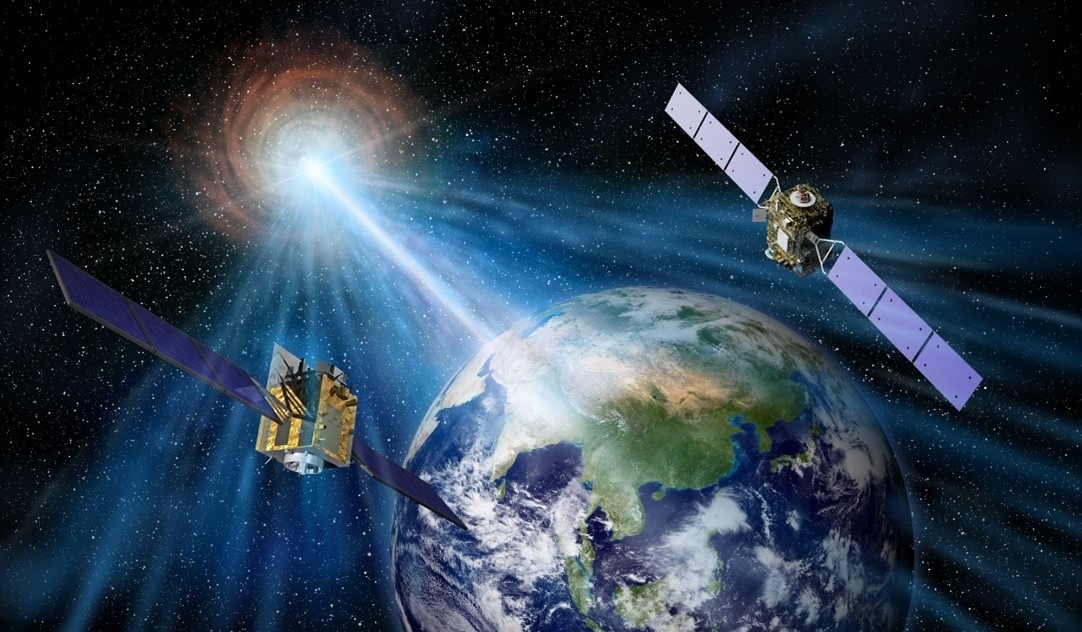On March 29th, 2023 (Beijing Time), at around 2 AM, the Institute of High Energy Physics (IHEP) of the Chinese Academy of Sciences (CAS), collectively with 40 research institutions across the world, released their breakthrough on the brightest Gamma-Ray Burst (dubbed as GRB 221009A) that has ever been detected by humans.

Illustration of the Insight-HXMT and GECAM-C observations of the brightest gamma-ray burst (GRB 221009A). Image Credit: IHEP/HXMT&GECAM Team
With the special observations made by two Chinese space telescopes, specifically Insight-HXMT and GECAM-C, researchers were able to precisely quantify how bright and how much energy was released by this burst, which is the key to comprehending this historical event.
As far as this historic gamma-ray burst is concerned, one more ground-based facility headed by IHEP, specifically Large High Altitude Air Shower Observatory (LHAASO), performed collective observation with the GECAM-C and Insight-HXMT telescopes. LHAASO made various significant first discoveries with its huge amount of very high energy observation data, which will be reported further.
Being the highly energetic explosion phenomenon in the universe, GRBs could be generated by the core collapse of a huge star, which normally lasts longer than two seconds, or the merge of two compact stars, like black holes and neutron stars, which typically lasts less than two seconds and releases gravitational waves. GRB 221009A comes under the former category.
With the availability of GECAM-C and Insight-HXMT space telescopes, an IHEP-led international group with scientists taking part from over 30 institutes from the USA, China, France, Italy, and Germany made precise measurements of the induced emission and early afterglow of this unparalleled burst in the hard X-Ray and soft gamma energy bands.
When this GRB arrived, GECAM-C functioned in a unique observation mode that has the potential to record extremely bright GRBs, similar to the brightest part of GRB 221009A, while several other space telescopes had issues recording such bright events.
Based on the accurate data obtained by GECAM-C, we found that this burst set new records on both the observed brightness and the isotropic-equivalent energy of all detected bursts, making this burst really exceptional.
Shaolin Xiong, Study Lead and Professor, Principal Investigator of GECAM-C, Chinese Academy of Sciences
Xiong added, “This burst is 50 times brighter than the last record-holder, and the isotropic-equivalent energy of this burst is more than 10^55 erg, which is about the total rest mass energy of eight solar masses. Such a huge energy was released just within about one minute in time.”
Insight-HXMT is China’s first X-Ray space telescope which has been developed to record X-Ray sources in the Milky Way.
Insight-HXMT made a clear measurement of GRB 221009A for its precursor and early afterglow, thanks to its very large detection area in MeV energy range. Luckily, we have Insight-HXMT and GECAM-C complementary to each other, so that we can have a full picture of this precious burst.
Shuangnan Zhang, Study Principal Investigator and Professor, Insight-HXMT of the IHEP
As per the collaborative observation by Insight-HXMT and GECAM-C, the early afterglow of GRB 221009A emerged to switch from slow decay to quick decay very early on, implying that this burst launched an extremely narrow and luminous jet directly pointing to us.
These findings shed new light on the physics of these energetic explosions in the universe. More detailed modeling is needed to understand how GRB engines manage to collimate the jets to produce such a huge isotropic equivalent energy in some cases.
Bing Zhang, Professor, University of Nevada
Zhang headed the theoretical interpretation in this work.